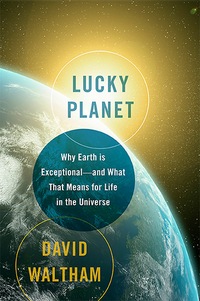Review: Lucky Planetby Jeff Foust
|
| “The usual situation is either biology freezes itself to death of that solar physics fried the world well before complex organisms ever evolve,” he writes. “We just happen to be living on one of the rare, lucky worlds where neither of those things happened.” |
In fact, there’s good reason to believe that this world, despite its size and orbit, is not particularly Earth-like. The planet is in the outer portions of the habitable zone of the M-class star it orbits, and gets only one-third the light that the Earth gets, about the same as Mars. It would need an atmosphere rich in carbon dioxide to generate a greenhouse effect strong enough to warm the planet above the freezing point of water—a world that, while warm enough to support life, might not be very much like the Earth.
That discovery is probably not very surprising to David Waltham, an astrobiologist and geophysicist at Royal Holloway, University of London. “[I]t is probably only a matter of time before it finds an Earth-sized planet circling within the habitable zone of a stellar system,” he writes of the Kepler mission early in his new book, Lucky Planet. “Indeed, announcement of such a world could well come between me finishing this book and its publication (an occupational hazard of discussing topical subjects.)” His timing is only slightly off: his book’s official publication date was April 8, just nine days before the announcement of the Kepler-186f discovery.
Waltham also likely isn’t particularly surprised to find that this exoplanet probably isn’t particularly much like the Earth. Indeed, the central thesis of his book is that, contrary to the claims of many scientists that Earth-like worlds, and thus life, may be common in the universe, the Earth may be an unusual world, and one of the few able to support complex, let alone intelligent, life.
This argument is based on his effort to understand why the Earth’s climate has been stable enough over billions of years to allow life to develop and evolve. The Sun initially was considerably fainter than it is today, requiring a stronger greenhouse effect in the Earth’s atmosphere to keep it warm enough for liquid water. That greenhouse effect, though, had to diminish as the Sun’s intensity increased over billions of years to avoid setting off a runaway greenhouse, turning the Earth into something like Venus.
Some attribute those changes to the “Gaia” hypothesis: that life itself regulates the planet, including the atmosphere, in ways to ensure that life thrives. Waltham, though, argues for an alternative he dubs the “Goldilocks” hypothesis: that’s it through sheer good fortune that our planet’s climate has evolved in such a way to sustain life, and that most other Earth-like worlds are not as lucky as us. “The usual situation is either biology freezes itself to death of that solar physics fried the world well before complex organisms ever evolve,” he writes. “We just happen to be living on one of the rare, lucky worlds where neither of those things happened.”
Later in the book, he builds on his argument of the Earth’s fortune by examining the role the Moon plans in our habitability. Many scientists have argued that the presence of the Moon is essential to habitability by stabilizing the Earth’s axis, preventing wild swings in the Earth’s axial inclination that could disrupt climate. His analysis makes the case that our Moon is almost too big: had it been just a little bigger when it formed as a result of a planetesimal colliding with the proto-Earth, the Earth-Moon system would have evolved to a point where resonances would start to make the Earth’s axial tilt unstable. An Earth with a smaller Moon, though, would spin more rapidly, and he argues that the stronger Coriolis force that results would allow for larger ice caps and more severe ice ages.
Waltham’s conclusion is that “highly habitable” worlds like the Earth may be very rare, although he notes that, given the sheer size of the universe, there will be many of them—just not anywhere near us, in all likelihood. This rules out, he believes, any chance of detecting intelligent life elsewhere in the observable universe. Simple life may be more common, including elsewhere in our solar system; however, he predicts that if microbial life is found on Mars, it likely had its origins on Earth, transported there via meteorites.
| What the book does illustrate is that, despite the scientific advances in recent decades, we still don’t know how common life is beyond Earth, and how likely it is to develop and survive. |
Lucky Planet makes, at the very least, an interesting contrarian case to the argument that Earth-like worlds, and life, may be cosmically common. That case is built largely on his own research, and it may be difficult for the reader to know how solid those arguments really are. He refers people to his website for a collection of his papers supporting his arguments; the work on the Moon’s role in stabilizing the Earth, for example, is only a two-page conference abstract.
What the book does illustrate is that, despite the scientific advances in recent decades, we still don’t know how common life is beyond Earth, and how likely it is to develop and survive. That’s because our data is still very limited: Earth is, after all, the only place we know that can support life, and even with Kepler’s discoveries, it will require future missions—perhaps decades hence—before we can determine if any of the potentially Earth-like worlds astronomers are finding are truly hospitable to life, let alone actually inhabited. It may be a long time before we know just how lucky we are.
